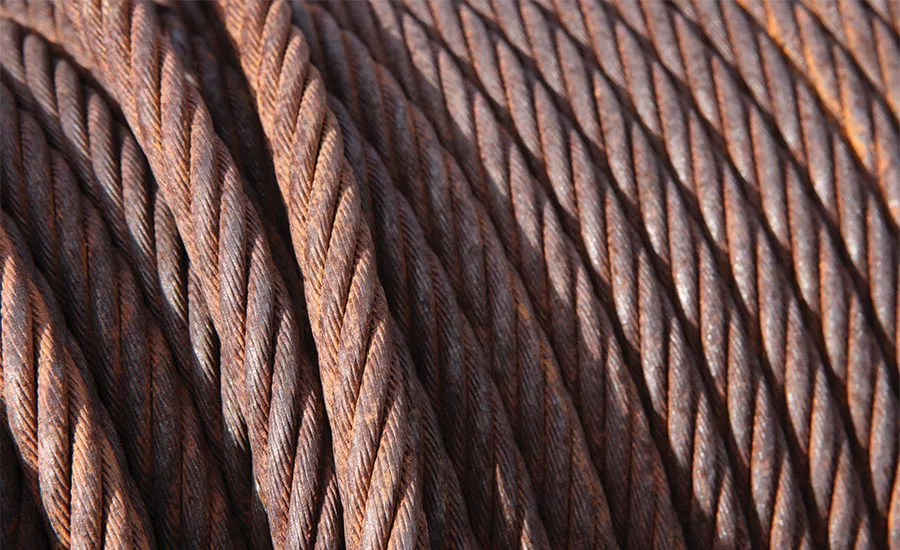What Are Wire-Rope Standards for Drillers?

How often do you inspect your wire ropes? I gave a presentation during the 2017 Groundwater Week event where I asked this question. Most everyone in the room of nearly 100 drillers said, “every day, as they run the rig.”
The next question I asked was, who has had a wire rope break on the job? Nearly every hand in the room, including mine, went up. How could this be? If we all are inspecting the wire rope every day, the rope should never be in a condition in which it could fail, right?
This realization should lead to the industry asking some questions. How much does the average driller really know about wire rope? What industry standards apply? Are there best practices references for wire rope use and inspection? Should inspections of wire rope be documented? Let’s get into the details for answers.
What Industry Standards Apply?
The Occupational Safety and Health Administration (OSHA) has determined that water well drilling equipment and activities, like oil and gas drilling, are covered by applicable requirements of 29 CFR Part 1910. In this decision, OSHA states, “Water well drilling, oil, and gas well drilling expose employees to similar hazards, therefore, employers engaged in drilling operations shall comply with appropriate General Industry Standards. This is an exception in classifying an industry when using the Standard Industrial Classification (SIC) manual but, is necessary for proper citing of water well drilling alleged violations.”
However, geothermal drilling fits the OSHA definition of construction. OSHA’s regulations define construction work as “construction, alteration, and/or repair, including painting and decorating.” Jim Martinek, OSHA Region 5 director, stated in a phone conversation on the topic of geothermal drilling’s applicable OSHA standards: “If the work fits the definition of construction, 29 CFR Part 1926 shall apply.” So, just as the formation dictates the way we drill a hole, the end use of a job dictates what OSHA regulations may apply.
For water well and geotech drilling, this includes 1910.176 Materials Handling and Storage, 1910.181 Derricks and 1910.184 Rigging/Slings, as well as the ANSI/ASME B30.9, B30.10 and B30.5. OSHA can cite each of these standards as industry best practices
For geothermal drilling, 1926.251 Materials Handling and Storage applies. In addition, we can refer to industry best practices under the “5(a)(1) general duty clause” Section 5(a)(1) of the OSH Act. That clause states: “Each employer shall furnish to each of his employees employment and a place of employment which are free from recognized hazards that are causing or are likely to cause death or serious physical harm to his employees.”
References for Best Practices
I recommend the following resources for best practices on wire rope use and maintenance:
- 1926.1400 Subpart CC Cranes & Derricks in Construction
- 1926.1413 Wire rope inspection
- 1926.1414 Wire Rope Selection and Installation Criteria
- 1926.1436 Derricks
- API RP 9B Recommended Practice on Application, Care and Use of Wire Rope for Oilfield Service
- API RP 54 Recommended Practices for Occupational Safety for Oil and Gas Well Drilling and Servicing Operations
- And ASME B30.5: Mobile and Locomotive (crane rope removal criteria)
I know what you are thinking: “Dedicated drill rigs are exempt from the 1926 OSHA crane standard.” I agree that a drill is not a crane. However, the API oil field standards and the sub part CC cranes in construction OSHA standards are identical with only a small exception in wire-rope safety factor when running casing. (The API granted themselves a safety factor reduction from 3 to 2 for setting casing. OSHA has a safety factor of 3 for all hoist lines except for rotation-resistant wire rope, which has a safety factor of 5 for drilling use.) Since these sister industries have standards that directly apply to similar uses of wire rope, the issues addressed in their standards are recognized hazards and it is reasonable that we should remediate those hazards by following the recommendations in those standards.
The problem with drilling is that we do not always do the best job of educating new employees, or even ourselves, as to what we need to do to properly maintain our wire rope, or even what to look for beyond the blatantly obvious to determine if a wire rope has outlived its safe usefulness. I am reminded of this every time I do a wire rope usage and inspection class and hear from the apprentices I teach about issues they see in the field. Many times, the issue is the driller either doesn’t know how to properly use/install the rope, or doesn’t properly inspect and remove from service a rope that is deficient in some way.
These types of problems are rare in the crane world as a great deal of effort is made to educate newer employees to the rights and wrongs of using, inspecting and discarding of wire rope. The drilling industry should have a similar safety record when if comes to wire-rope failures. Sadly, we do not. If you ask a room of 100 crane operators who has had a wire rope break during a lift, you would more than likely not see any hands raised. We, as an industry, can and should do better.
To check out more of our columns, click here!
This wire-rope discussion is too complicated to handle in a single, under-1,000 word article. To address this issue as fully as possible, the next few articles will build on this topic. I aim to assist you in educating yourself (if need be) and any employees new to the drilling industry.
Looking for a reprint of this article?
From high-res PDFs to custom plaques, order your copy today!







